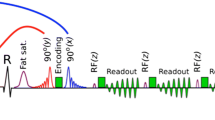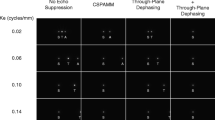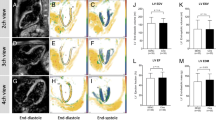Abstract
Purpose
Right ventricular (RV) function is increasingly recognized for its prognostic value in many disease states. As with the left ventricle (LV), strain-based measurements may have better prognostic value than typical chamber volumes or ejection fraction. Complete functional characterization of the RV requires high-resolution, 3D displacement tracking methods, which have been prohibitively challenging to implement. Zonal excitation during Displacement ENcoding with Stimulated Echoes (DENSE) magnetic resonance imaging (MRI) has helped reduce scan time for 2D LV strain quantification. We hypothesized that zonal excitation could alternatively be used to reproducibly acquire higher resolution, 3D-encoded DENSE images for quantification of bi-ventricular strain within a single breath-hold.
Methods
We modified sequence parameters for a 3D zonal excitation DENSE sequence to achieve in-plane resolution < 2 mm and acquired two sets of images in eight healthy adult male volunteers with median (IQR) age 32.5 (32.0–33.8) years. We assessed the inter-test reproducibility of this technique, and compared computed strains and torsion with previously published data.
Results
Data for one subject was excluded based on image artifacts. Reproducibility for LV (CoV: 6.1–9.0%) and RV normal strains (CoV: 6.3–8.2%) and LV torsion (CoV = 7.1%) were all very good. Reproducibility of RV torsion was lower (CoV = 16.7%), but still within acceptable limits. Computed global strains and torsion were within reasonable agreement with published data, but further studies in larger cohorts are needed to confirm.
Conclusion
Reproducible acquisition of 3D-encoded biventricular myocardial strain data in a breath-hold is feasible using DENSE with zonal excitation.




Similar content being viewed by others
Abbreviations
- RV:
-
Right ventricle
- LV:
-
Left ventricle
- DENSE:
-
Displacement ENcoding with Stimulated Echoes
- MRI:
-
Magnetic resonance imaging
- CoV:
-
Coefficient of variation
- SENC:
-
Strain encoded
- ARVC:
-
Arrhythmogenic right ventricular cardiomyopathy
- ZE:
-
Zonal excitation
- RF:
-
Radiofrequency
- FOV:
-
Field of view
- TR:
-
Repetition time
- TE:
-
Echo time
- SNR:
-
Signal to noise ratio
- IQR:
-
Inter-quartile range
- SD:
-
Standard deviation
- E RR, E CC, E LL :
-
Radial, circumferential, longitudinal normal strain, respectively
References
Abdishektaei M, Feng X, Meyer CH, Epstein FH (2019) DAS-Net: A generative adversarial net to suppress artifact-generating echoes in DENSE MRI. In: Proceedings of the International Society for Magnetic Resonance in Medicine. p 1089
Amundsen, B. H., T. Helle-Valle, T. Edvardsen, et al. Noninvasive myocardial strain measurement by speckle tracking echocardiography: Validation against sonomicrometry and tagged magnetic resonance imaging. J. Am. Coll. Cardiol. 47:789–793, 2006. https://doi.org/10.1016/j.jacc.2005.10.040.
Amzulescu, M. S., M. De Craene, H. Langet, et al. Myocardial strain imaging: Review of general principles, validation, and sources of discrepancies. Eur. Heart J. Cardiovasc. Imaging 20:605–619, 2019. https://doi.org/10.1093/ehjci/jez041.
Auger, D. A., X. Zhong, F. H. Epstein, and B. S. Spottiswoode. Mapping right ventricular myocardial mechanics using 3D cine DENSE cardiovascular magnetic resonance. J. Cardiovasc. Magn. Reson. 14:4, 2012. https://doi.org/10.1186/1532-429X-14-4.
Benjamini, Y., and Y. Hochberg. Controlling the false discovery rate: A practical and powerful approach to multiple testing. J. R. Stat. Soc. Ser. B 57:289–300, 1995.
Bland, J. M., and D. Altman. Statistical methods for assessing agreement between two methods of clinical measurement. Lancet 47:931–936, 1986. https://doi.org/10.1016/j.ijnurstu.2009.10.001.
Cameli, M., M. Lisi, F. M. Righini, et al. Right ventricular longitudinal strain correlates well with right ventricular stroke work index in patients with advanced heart failure referred for heart transplantation. J. Card. Fail. 18:208–215, 2012. https://doi.org/10.1016/j.cardfail.2011.12.002.
Cao, J. J., N. Ngai, L. Duncanson, et al. A comparison of both DENSE and feature tracking techniques with tagging for the cardiovascular magnetic resonance assessment of myocardial strain. J. Cardiovasc. Magn. Reson. 2018. https://doi.org/10.1186/s12968-018-0448-9.
Carruth, E. D., W. Young, D. Beer, et al. Prevalence and electronic health record-based phenotype of loss-of-function genetic variants in arrhythmogenic right ventricular cardiomyopathy-associated genes. Circ. Genomic Precis Med. 12:487–494, 2019. https://doi.org/10.1161/CIRCGEN.119.002579.
Chen, X., Y. Yang, X. Cai, et al. Accelerated two-dimensional cine DENSE cardiovascular magnetic resonance using compressed sensing and parallel imaging. J. Cardiovasc. Magn. Reson. 18:38, 2016. https://doi.org/10.1186/s12968-016-0253-2.
Claus, P., A. M. S. Omar, G. Pedrizzetti, et al. Tissue tracking technology for assessing cardiac mechanicsprinciples, normal values, and clinical applications. JACC Cardiovasc. Imaging 8:1444–1460, 2015. https://doi.org/10.1016/j.jcmg.2015.11.001.
D’Hooge, J., A. Heimdal, F. Jamal, et al. Regional strain and strain rate measurements by cardiac ultrasound: Principles, implementation and limitations. Eur. J. Echocardiogr. 1:154–170, 2000. https://doi.org/10.1053/euje.2000.0031.
Fielden SW, Carruth ED, Nevius CD, et al (2020) Deep learning for undersampled spiral DENSE reconstruction. In: Proceedings of the International Society for Magnetic Resonance in Medicine. p 3618
Fu, Q., B. Xu, Y. Liu, et al. Insulin inhibits cardiac contractility by inducing a Gi-biased β2-adrenergic signaling in hearts. Diabetes 63:2676–2689, 2014. https://doi.org/10.2337/db13-1763.
Gilliam A.D., Suever J. D. DENSE analysis. 2016. https://github.com/denseanalysis/denseanalysis.
Haddad, F., R. Doyle, D. J. Murphy, and S. A. Hunt. Right ventricular function in cardiovascular disease, part II: Pathophysiology, clinical importance, and management of right ventricular failure. Circulation 117:1717–1731, 2008. https://doi.org/10.1161/CIRCULATIONAHA.107.653584.
Haggerty, C. M., S. P. Kramer, C. M. Binkley, et al. Reproducibility of cine displacement encoding with stimulated echoes (DENSE) cardiovascular magnetic resonance for measuring left ventricular strains, torsion, and synchrony in mice. J. Cardiovasc. Magn. Reson. 15:71, 2013. https://doi.org/10.1186/1532-429X-15-71.
Haggerty, C. M., J. D. Suever, A. Pulenthiran, et al. Association between left ventricular mechanics and diffuse myocardial fibrosis in patients with repaired Tetralogy of Fallot: A cross-sectional study. J. Cardiovasc. Magn. Reson. 19:100, 2017. https://doi.org/10.1186/s12968-017-0410-2.
Hamada-Harimura, Y., Y. Seo, T. Ishizu, et al. Incremental prognostic value of right ventricular strain in patients with acute decompensated heart failure. Circ. Cardiovasc. Imaging 11:2018. https://doi.org/10.1161/CIRCIMAGING.117.007249.
Hamdan, A., T. Thouet, K. Sebastian, et al. Regional right ventricular function and timing of contraction in healthy volunteers evaluated by strain-encoded MRI. J. Magn. Reson. Imaging 28:1379–1385, 2008. https://doi.org/10.1002/jmri.21526.
Heermann, P., D. M. Hedderich, M. Paul, et al. Biventricular myocardial strain analysis in patients with arrhythmogenic right ventricular cardiomyopathy (ARVC) using cardiovascular magnetic resonance feature tracking. J. Cardiovasc. Magn. Reson. 16:75, 2014. https://doi.org/10.1186/s12968-014-0075-z.
Hor, K. N., W. M. Gottliebson, C. Carson, et al. Comparison of magnetic resonance feature tracking for strain calculation with harmonic phase imaging analysis. JACC Cardiovasc. Imaging 3:144–151, 2010. https://doi.org/10.1016/j.jcmg.2009.11.006.
Jing, L., C. M. Haggerty, J. D. Suever, et al. Patients with repaired tetralogy of Fallot suffer from intra- and inter-ventricular cardiac dyssynchrony: A cardiac magnetic resonance study. Eur. Heart J. Cardiovasc. Imaging 15:1333–1343, 2014. https://doi.org/10.1093/ehjci/jeu123.
Jing, L., G. J. Wehner, J. D. Suever, et al. Left and right ventricular dyssynchrony and strains from cardiovascular magnetic resonance feature tracking do not predict deterioration of ventricular function in patients with repaired tetralogy of Fallot. J. Cardiovasc. Magn. Reson. 18:49, 2016. https://doi.org/10.1186/s12968-016-0268-8.
Kar, J., A. K. Knutsen, B. P. Cupps, et al. Three-dimensional regional strain computation method with displacement encoding with stimulated echoes (DENSE) in non-ischemic, non-valvular dilated cardiomyopathy patients and healthy subjects validated by tagged MRI. J. Magn. Reson. Imaging 00:1–11, 2014. https://doi.org/10.1002/jmri.24576.
Kovács, A., B. Lakatos, M. Tokodi, and B. Merkely. Right ventricular mechanical pattern in health and disease: beyond longitudinal shortening. Heart Fail. Rev. 24(4):511–520, 2019.
Matsukubo, H., T. Matsuura, N. Endo, et al. Echocardiographic measurement of right ventricular wall thickness. A new application of subxiphoid echocardiography. Circulation 56:278–284, 1977. https://doi.org/10.1161/01.CIR.56.2.278.
Moore, C. C., C. H. Lugo-Olivieri, E. R. McVeigh, and E. A. Zerhouni. Three-dimensional systolic strain patterns in the normal human left ventricle: Characterization with tagged MR imaging. Radiology 214:453–466, 2000. https://doi.org/10.1148/radiology.214.2.r00fe17453.
Nagao, M., Y. Yamasaki, M. Yonezawa, et al. Interventricular dyssynchrony using tagging magnetic resonance imaging predicts right ventricular dysfunction in adult congenital heart disease. Congenit. Heart Dis. 10:271–280, 2015. https://doi.org/10.1111/chd.12217.
Pan, L., M. Stuber, D. L. Kraitchman, et al. Real-time imaging of regional myocardial function using fast-SENC. Magn. Reson. Med. 55:386–395, 2006. https://doi.org/10.1002/mrm.20770.
Scatteia, A., A. Baritussio, and C. Bucciarelli-Ducci. Strain imaging using cardiac magnetic resonance. Heart Fail. Rev. 10:2, 2017. https://doi.org/10.1007/s10741-017-9621-8.
Schlemper, J., J. Caballero, J. V. Hajnal, et al. A deep cascade of convolutional neural networks for dynamic MR image reconstruction. IEEE Trans. Med. Imaging 37:491–503, 2018. https://doi.org/10.1109/TMI.2017.2760978.
Scott, A. D., U. Tayal, S. Nielles-Vallespin, et al. Accelerating cine DENSE using a zonal excitation. J. Cardiovasc. Magn. Reson. 2016. https://doi.org/10.1186/1532-429x-18-s1-o50.
Smith, B. C. F., G. Dobson, D. Dawson, et al. Three-dimensional speckle tracking of the right ventricle: Toward optimal quantification of right ventricular dysfunction in pulmonary hypertension. J. Am. Coll. Cardiol. 64:41–51, 2014. https://doi.org/10.1016/j.jacc.2014.01.084.
Spottiswoode, B. S., X. Zhong, A. T. Hess, et al. Tracking myocardial motion from cine DENSE images using spatiotemporal phase unwrapping and temporal fitting. IEEE Trans. Med. Imaging 26:15–30, 2007. https://doi.org/10.1109/TMI.2006.884215.
Stanton, T., R. Leano, and T. H. Marwick. Prediction of all-cause mortality from global longitudinal speckle strain: Comparison with ejection fraction and wall motion scoring. Circ. Cardiovasc. Imaging 2:356–364, 2009. https://doi.org/10.1161/CIRCIMAGING.109.862334.
Stuber, M., M. A. Spiegel, S. E. Fischer, et al. Single breath-hold slice-following CSPAMM myocardial tagging. MAGMA 9:85–91, 1999.
Suever, J. D., G. J. Wehner, L. Jing, et al. Right ventricular strain, torsion, and dyssynchrony in healthy subjects using 3D spiral cine DENSE magnetic resonance imaging. IEEE Trans. Med. Imaging 36:1076–1085, 2017. https://doi.org/10.1109/TMI.2016.2646321.
Tayal, U., R. Wage, P. F. Ferreira, et al. The feasibility of a novel limited field of view spiral cine DENSE sequence to assess myocardial strain in dilated cardiomyopathy. Magn. Reson. Mater. Phys. Biol. Med. 32:317–329, 2019. https://doi.org/10.1007/s10334-019-00735-5.
Taylor, A. J., M. Salerno, R. Dharmakumar, and M. Jerosch-Herold. T1 mapping basic techniques and clinical applications. JACC Cardiovasc. Imaging 9:67–81, 2016.
Tello, K., A. Dalmer, R. Vanderpool, et al. Cardiac magnetic resonance imaging-based right ventricular strain analysis for assessment of coupling and diastolic function in pulmonary hypertension. JACC Cardiovasc. Imaging 2019. https://doi.org/10.1016/j.jcmg.2018.12.032.
Vigneault, D. M., A. S. J. M. te Riele, C. A. James, et al. Right ventricular strain by MR quantitatively identifies regional dysfunction in patients with arrhythmogenic right ventricular cardiomyopathy. J. Magn. Reson. Imaging 43:1132–1139, 2016. https://doi.org/10.1002/jmri.25068.
Wehner, G. J., L. Jing, C. M. Haggerty, et al. Comparison of left ventricular strains and torsion derived from feature tracking and DENSE CMR. J. Cardiovasc. Magn. Reson. 20:1–11, 2018. https://doi.org/10.1186/s12968-018-0485-4.
Wehner, G. J., J. D. Suever, C. M. Haggerty, et al. Validation of in vivo 2D displacements from spiral cine DENSE at 3T. J. Cardiovasc. Magn. Reson. 17:1–11, 2015. https://doi.org/10.1186/s12968-015-0119-z.
Zhong, X., B. S. Spottiswoode, C. H. Meyer, et al. Imaging three-dimensional myocardial mechanics using navigator-gated volumetric spiral cine DENSE MRI. Magn. Reson. Med. 64:1089–1097, 2010. https://doi.org/10.1002/mrm.22503.
Funding
Research reported in this publication was supported by the National Heart, Lung, And Blood Institute of the National Institutes of Health under Award Number R01HL141901. The content is solely the responsibility of the authors and does not necessarily represent the official views of the National Institutes of Health.
Availability of Data and Material
Data for this work will not be made available.
Code Availability
DENSEanalysis software used for this work is freely available for public use: (http://www.github.com/suever/denseanalysis/denseanalysis).
Conflict of interest
All authors declare that they have no conflict of interest.
Ethical Approval
All procedures followed were in accordance with the ethical standards of the responsible committee on human experimentation (institutional and national) and with the Helsinki Declaration of 1975, as revised in 2000 (5). Informed consent was obtained from all patients for being included in the study.
Author information
Authors and Affiliations
Corresponding author
Additional information
Associate Editor Ajit P. Yoganathan oversaw the review of this article.
Publisher's Note
Springer Nature remains neutral with regard to jurisdictional claims in published maps and institutional affiliations.
Rights and permissions
About this article
Cite this article
Carruth, E.D., Fielden, S.W., Nevius, C.D. et al. 3D-Encoded DENSE MRI with Zonal Excitation for Quantifying Biventricular Myocardial Strain During a Breath-Hold. Cardiovasc Eng Tech 12, 589–597 (2021). https://doi.org/10.1007/s13239-021-00561-8
Received:
Accepted:
Published:
Issue Date:
DOI: https://doi.org/10.1007/s13239-021-00561-8




